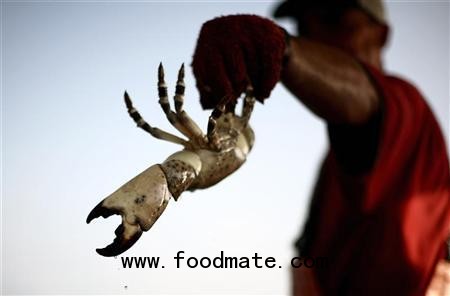
Record low hauls of stone crabs off the coast of Florida are creating a scarcity of one of the holiday season's favorite seafood delicacies, pushing up prices and sparking a bidding wars among high-end restaurants.
"No question, there is a shortage and people are feeling it," said Roger Duarte, a former investment banker and owner of Miami-based supplier George's Stone Crab. "I have clients calling me who I have never had business with. Everyone is looking for stone crabs anywhere they can get them," he said.
During an average season, which runs from October 15 to May 15, Duarte, 29, said his fleet of 80 boats can pull in up to 5,000 pounds a day. Yet in the first two months of this year that's fallen to about 1,000 pounds a day.
At the same time Duarte said wholesale prices are up 70 percent to 80 percent. About 60 percent of his crabs are shipped around the country, mostly to clients in New York City and Chicago.
Buddy Becker, who runs a fishery in the Florida Keys, said local fishermen are laying off crew and downsizing to smaller boats to cut costs.
"It's a situation where you can't financially go out there, pull traps, put fresh bait in them and not make any money," he said.
Some fisherman have already called it quits for the season. But Becker thinks that such a move is "a little premature. We're going to let sit over the holidays, go out the first of January and depending on what we catch, we'll let them sit for another couple of weeks."
Fishermen and researchers are unable to determine what is causing a reduced catch, but many suspect it is a combination of a booming octopus population, cooler weather, rough seas and a lingering red tide, which is killing the crab's food.
"Every trap you pull up there's an octopus in there," Becker said.
When stone crabs get stuck in a fisherman's trap they become "sitting ducks" for octopus, said Ryan Gandy, a research scientist for the Florida Fish and Wildlife Conservation Commission. "They'll eat the stone crabs in the trap and in some instances set up house in there because the food comes to them," he said.
Duarte of George's Stone Crab said his fisherman have also noticed the size of the octopus has grown, from one or two pounds to as much as eight.
Florida officials estimated 2.7 million pounds of claws worth $23.6 million were hauled in during the 2011-2012 season.
Though this season's figures look to be some of the worst on record, Gandy said the total catch tends to rise and fall over the long term. The number of juvenile crabs is stable or increasing, which bodes well for future seasons.
Diners only see and eat the crabs' claws. Fishermen detach them at sea - one claw per crab - and toss the animal back into the water where it can regrow the lost limb.
Besides being a rare, sustainable sea-food, fresh stone crab is known for its sweetness as well as the large claws with chunky mouthfuls of crab meat.
At the 100-year-old famed Joe's Stone Crab restaurant on Miami Beach, a half-dozen, modest-sized claws - served with traditional mustard sauce - can fetch more than $40 depending on the market price.
One pound of medium claws that fishermen used to sell for $8.50, now sells for $14, with jumbo claws fetching more than $20 per pound.
Fewer fishermen on the water could mean an even smaller supply, further pushing up prices further and forcing some vendors to dip into frozen stock to meet nationwide demand.
"I'm lucky if I can supply half of the demand I am getting," said Duarte.





